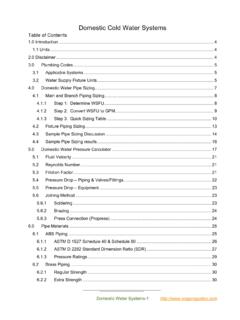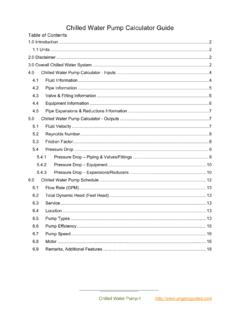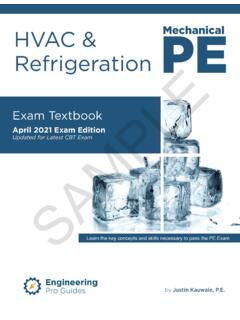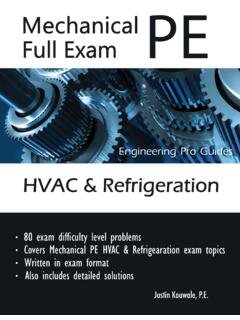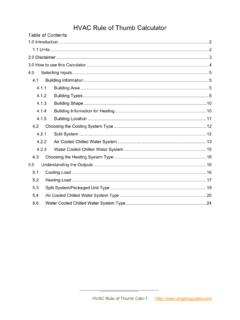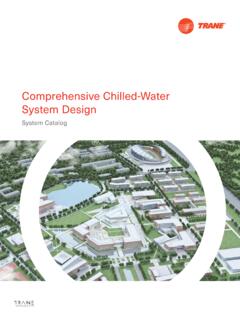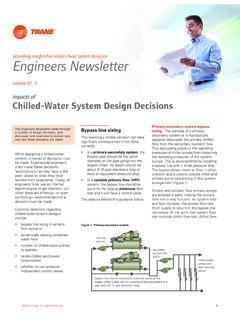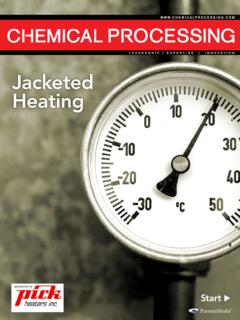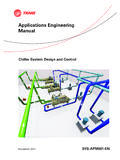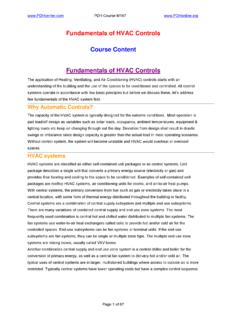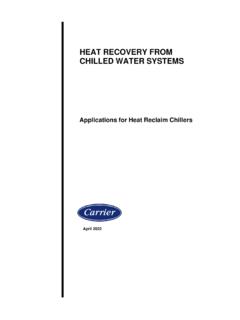Transcription of Expansion Tank (CHW)-FINAL - Engineering Pro Guides
1 Expansion Tank (CHW)-1 Expansion Tank Design ( chilled water ) Table of Contents Introduction .. 2 Units .. 2 Disclaimer .. 2 Expansion Tank Types .. 2 Open Tank .. 2 Closed Tank with No Bladder .. 3 Closed Tank with Bladder/Diaphragm .. 4 Definitions of Equation Inputs .. 6 Sizing an Expansion Tank .. 6 Determining Temperature Values .. 6 Determining Specific Volume Values .. 7 Determining Pressure Values .. 7 Low/Fill Pressure .. 7 High Pressure .. 10 Point of No Pressure Change .. 13 Linear Coefficient of Thermal Expansion .
2 13 Expansion Tank Design Issues .. 14 Locating the Tank .. 14 Tank Located at CHWP Suction .. 14 Tank Located at Highest Point .. 15 Tank Materials .. 16 Tank Manufacturers .. 17 Ancillary Devices .. 17 Expansion Tank Calculator .. 18 Fluid Inputs .. 18 Piping Inputs .. 18 Equipment Inputs .. 19 Expansion Tank Outputs .. 19 Expansion Tank (CHW)-2 INTRODUCTION An Expansion tank is used in a chilled water system to accomplish three main tasks, (1) accommodate thermal Expansion of the chilled water , (2) maintain positive pressure at all points in the system at all times and (3) maintain net positive suction head at the chilled water pump(s).
3 There are other techniques and equipment besides the Expansion tank that help to accomplish these three purposes, but only the ways the Expansion tank affects these three purposes will be discussed in this guide. In addition, the three Expansion tank types will be discussed, along with their sizing equations. The three types of Expansion tanks are (1) open, (2) closed and (3) diaphragm. Finally design elements related to Expansion tanks will be discussed, which include locating the Expansion tank, tank materials, tank manufacturers and UNITS The primary units that are used in this calculator and guide are the United States Customary System Units (USCS).
4 However, there will be another version provided in International System of Units (SI). DISCLAIMER In no event will Engineering Pro Guides be liable for any incidental, indirect, consequential, punitive or special damages of any kind, or any other damages whatsoever, including, without limitation, those resulting from loss of profit, loss of contracts, loss of reputation, goodwill, data, information, income, anticipated savings or business relationships, whether or not Engineering Pro Guides has been advised of the possibility of such damage, arising out of or in connection with the use of this document/software or any referenced documents and/or websites.
5 This book/software was created on the basis of Expansion TANK TYPES There are several types of Expansion tanks provided by various manufacturers. However, there are only three main types for equation purposes. This section will take the major manufacturers and their Expansion tank models and classify each model within one of the three Expansion tank equations. The three main Expansion tank sizing equations are (1) open tank, (2) closed tank with no bladder and (3) closed tank with bladder. OPEN TANK An open tank will most likely not be used in your HVAC system design, but it is shown here for completeness.
6 An open tank consists of a large tank with an opening to the atmosphere. As temperature in the system builds, the fluid expands into the tank as shown in the figure below. Expansion Tank (CHW)-3 Figure 1: The figure on the left shows the open Expansion tank when the fluid temperature is cold. As the temperature rises, the fluid expands and begins to increase the volume within the Expansion tank. This is shown as red in the figure to the right. The open tank is typically located at the top of the system. The open tank is governed by the below equation. The 1 term describes the percentage change in volume of the system volume.
7 The 3 term describes the percent change in piping volume due to the Expansion of the piping. This term is subtracted from the percent change in volume term because the pipe Expansion will help to offset the Expansion in liquid volume. 2 1 3 Please see section for description of the variables and units. CLOSED TANK WITH NO BLADDER The closed Expansion tank with no bladder does not have any openings to the atmosphere. It is simply a closed tank with a connection to the chilled water system. The closed tank has extra space that is filled with air, when the temperature in the system is cold.
8 As the temperature within the chilled water system rises, the volume expands and fills the empty space within the tank. Expansion Tank (CHW)-4 Figure 2: A closed tank with no bladder has free space when the chilled water system is cold. As the temperature within the system rises, the water expands into the free space within the tank. The equation that governs the closed tank is shown below. This equation follows the same basic format as the open tank, except that the constant 2 is replaced with the / / term. This term describes the change in pressure that can be accommodated at the Expansion tank.
9 In the open tank, no pressure change can be accommodated. The open tank will fill as the liquid expands, but once the tank volume is filled, any additional volume will overfill the tank and no pressure change will be experienced. The closed tank on the other hand can accommodate an increase in volume and pressure. As the liquid expands the volume in the tank increases. Then, once the volume is filled, the closed tank will no longer increase in volume but will increase in pressure. This way the Expansion tank can accommodate more liquid Expansion with a lesser volume. 1 3 / / Please see section for description of the variables and units.
10 CLOSED TANK WITH BLADDER/DIAPHRAGM A closed tank with a bladder or diaphragm is the most common Expansion tank. This Expansion tank is similar to a closed tank, except within the tank there is a bladder or diaphragm that separates the water and the air. As the chilled water volume expands the water pushes against the bladder or diaphragm. The bladder or diaphragm serves as a barrier between the air and the water to limit the air that can be entrained into the water . The bladder or diaphragm also allows the air within the bladder or diaphragm to be pre-charged or pressurized. The importance of pressurizing the air is that it determines the pressure that the chilled water must achieve before the Expansion tank accepts volume.
